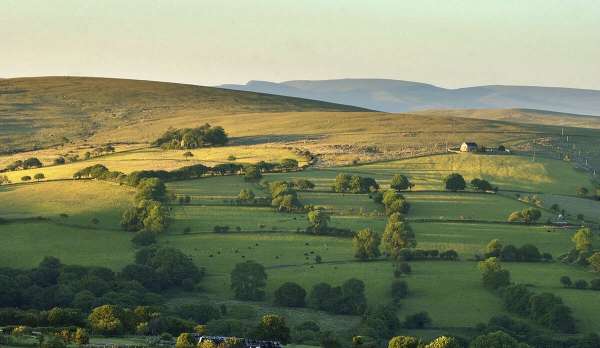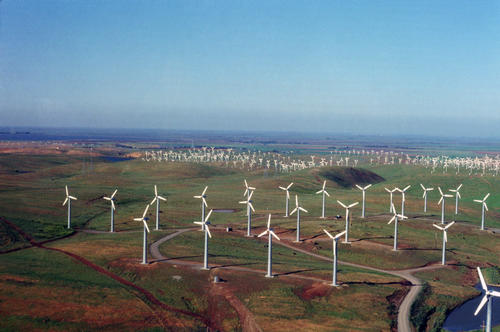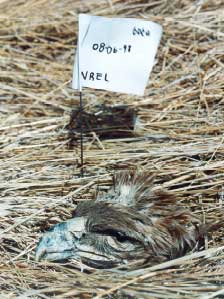| Windfarms : the killing of Scottish eagles will not stop |
(3626) |
| ORNITHOLOGISTS RETREAT INTO SILENCE, THEN RESORT TO SMEAR, AND FINALLY TO BURLESQUE. |
It is disturbing enough that ornithologists would not object to the massacre of 200 protected golden eagles. But their allegation that the killing will stop after the first year of operation has no scientific leg to stand on .
As I refuted their stand, and proved the risk of extinction to be real, a smear campaign was launched against me. Then burlesque caught up.
|
.
.

Above picture : gently rolling hills in Wales, soon to be ruined by a windfarm. The whole Welsh landscape is condemned by a senseless windfarm policy. There are no resident eagles in Wales : the victims to date have been two red kites and a swan . But as no monitoring is being done, many other birds may be impacted that we shall never know about .
NOTE : PLEASE REPORT ANY DEFECTIVE LINKS BY POSTING A COMMENT AT THE END. Thank you.
For years I have been asking that the impact of windfarms on birds be assessed cumulatively, not on a case-by-case basis. But my calls remained unanswered. The ornithological community, public authorities, bird societies, and the European Commission have turned a deaf ear.
One small effort was made : a report was published about golden eagles . It concluded that 500 windfarms in Scotland would only affect 4% of the territory of adult eagles, and 2% of that of non-adults. But I showed that this study was built on two terminally-flawed assumptions : The shame of Scotland Section 1 : reasoning like poachers and section 3 : the core range manipulation.
Publishing such a biased and misleading report was worse than publishing none at all, and it raised the question of ethics.
I then decided to publish a model, simplified to the extreme, showing what could happen to the population of golden eagles in Scotland. It pointed towards national extinction. I also invited, once more, SNH and the RSPB to see for themselves using their own models (1). That was a fair suggestion, may I add - see : Windfarms to wipe out Scottish eagles - Note 2 to the model ( under the second table ).
They wouldn´t do it . Instead, it was thought expedient to criticise my model for not being representative of reality.
- Primitive as it was, the opposite would have been surprising.
But then my critic wrote these amazing words :
"...the deaths of adult birds stop right there at the end of year 1. The territories are empty and the mortality of breeding pairs in the windfarm-affected territories has ended."(2)

Above picture : Altamont Pass windfarm, California. Now imagine these turbines implanted into the Welsh landscape shown in the first picture...
My critic was pretending that the killings of adults would stop after the first year. This was another clear case of bias. For it is a fact that neighbouring adults will investigate vacant territories – if only because prey becomes more abundant after the death of resident eagles.
This use of inaccurate statements to prove me wrong prompted me to add a third footnote to my model :
quote:
“3) - since publication, a critic deliberately ignored Note 2 above and challenged the table´s mortality figures. So I will say this : in real life, 300 golden eagles or more may be killed in the first year, of all ages. For in addition to the breeding pair, each of the 100 windfarms may also kill their young ( where applicable ), plus intruders ( if any ). Then there are windarms that overlap several eagle ranges ( such as Eishken, Lewis, Pairc etc. ), likely to kill 4 - 6 adults and 2 - 3 sub-adults. Finally, there are those located within busy dispersion areas ( such as Edinbane/Ben Aketil, Allt Dearg**, etc. ), that may kill up to 10 - 12 young GE´s in the first year.
** The Allt Dearg project was rejected by Councillors, but it is not dead.
In the years following year one, mortality will affect adult eagles from neighbouring territories, as they investigate hunting areas that have become vacant next to theirs, and where prey has become more abundant. It will also affect immatures or floaters that may be hunting there, or trying to form a pair, or just passing through. Finally, more young eagles will be killed by wind turbines in the dispersion areas ( Edinbane etc. ).
Once the adults of neighbouring territories have been killed, attrition in the remaining adult population will continue because of a sharp decline in the recruitment rate. Young birds, as they roam over the country from hill to hill, will be decimated by windfarms sited on them : those within dispersion areas, plus those within the 100 territories now vacant.
Recruitment is bound to become a major problem. Already, with persecution and other causes of death, only about 50 young GE reach adulthood each year in Scotland (3). Windfarms in excess of 100, sited in places that are attractive to these young eagles, will have a devastating impact.
After 20 years, most of the remaining adults will have died of old age. For lack of recruitment, few will be replaced. Those living in the few Special Protection Areas that will have remained turbine-free will face the same fate. Their young roam across the country like any other."
unquote
This 20-year projection, based on existing mortality data, real life observations, and common sense, evidenced more than ever the seriousness of the risk of extinction.
- It was not challenged by critics.

Above picture : one of the numerous victims of the Altamont Pass windfarm, California.
The purpose of my model had been to invite discussion on cumulative effect. But SNH and the RSPB would not have it. They had been wrong, and saw no reason to admit it.
The 20-year projection caused my main opponent to retreat into silence. This prompted another high-profile ornithologist to step in, insensitive to ridicule as he drew a parallel between me and GW Bush. We were suddenly out of science and into smear, promptly followed by diversion. Indeed, we moved right into burlesque with his improbable comparison :
"Demographic difficulties occur in human populations, too. If you
keep track of the news, you will find that countries such as Japan
and Russia have severe demograpic difficulties. Even the U.S. is
approaching a period of demographic difficulty as "baby boomers" get
set to retire and draw on social welfare programs, with far fewer
young workers to keep the financial aspect of social security
afloat. This is a genuine demographic difficulty!"
Obviously, the Scottish eagles having no social security to finance, they couldn´t possibly be in genuine demographic difficulty !
Nevertheless, we are all indebted to him for evidencing the shallowness of scientific arrogance. For this man never missed an occasion in the past to flaunt "best available science."
CONCLUSION
Some ornithologists will go to any lengths to pretend that the machines their employers support are not harmful to birds. Conflict of interest is acute. But the risk of extirpation (4), in Scotland, is real : to the golden eagle, as well as the white-tailed eagle, whose population is several times smaller .
Soon it will be too late to save these magnificent birds. We need a law, one that would preserve their last strongholds, i.e. the Hebrides and Argyll, from the installation of windfarms. It is the last chance for the Scottish eagles.
Mark Duchamp....................................... November 28th 2007
The negative effects of windfarms: links to papers published by Mark Duchamp
PICTURES
FOOTNOTES :
(1) - SNH : Scottish Natural Heritage, an agency of the Scottish Executive.
RSPB : Royal Society for the Protection of Birds - over 1 million members and 1,000 full-time employees.
(2) – the deaths of adult birds stop right there
(3)– recruits are probably around 50 a year
(4) - Extirpation is not much different from extinction. It generally refers to an extinction that is limited to a region or country : in this case, Scotland ( and the UK by extension, as there is only one pair of GE in England, none in Wales, and GE´s are just being reintroduced into Northern Ireland ).
| Insertado
por: Mark Duchamp (28/11/2007) |
| Fuente/Autor:
Mark Duchamp |
Valoración
Comentarios
Elizabeth Banks
27 Berrys Road Wonthaggi Vic Australia |
| Nombre: - (01/12/2007) |
E-mail: jongebloed@dcsi.net.au |
| |
|
